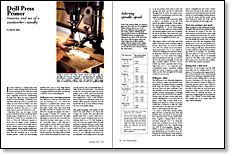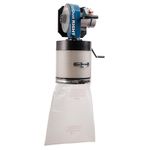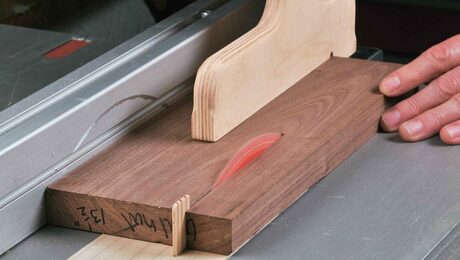Drill Press Primer
Anatomy and use of a woodworker's standby
Synopsis: Bernie Maas says that while the drill press is a premier hole maker, it makes quick work of mortises and it’s quiet and fairly safe to use. He explains benchtop and floor-standing drill presses, their parts and purposes, and safety. He details how to maintain good quality: controlling feed rate, pressure, and speed. He explains how to bore and what to use to protect your bit and table, and addresses fixtures and table vises, as well as other functions and accessories. Side information addresses choosing the right bit and how to keep it sharp.
If your solutions to boring holes have been a wrist-cracking brace and bit and an ear-straining electric drill, then you’ll break into a smile when you crank up a drill press. Originally devised for metalworking, the drill press offers the same professional results for woodworking: consistently accurate holes. While the press is a premier hole maker, its name belies its ability to do other work, such as mortising. In contrast to most stationary machines, the press is a quick study, and it’s quiet and fairly safe to use.
Basically, there are two types of drill presses: benchtop and floor standing. Bench models range in height from 22 in. to 46 in., while floor models can be anywhere from 52-in. to 76-in. tall. Drill-press capacity or throat size—the largest circular workpiece you can bore a central hole through and not hit the column with—is often expressed as swing or diameter. Bench models usually have a swing from 8 in. to 12 in. Floor models range from l0-in.-dia. machines up to 21-in.-dia. monster presses. I prefer the floor-standing models in the 11-in. to 16-in. range because they can be positioned in tight spots without occupying valuable bench space, and this size is ideal for most woodworking jobs.
Drill-press parts and their purposes
The drill press is made up of four basic parts, which are clamped to a polished steel column. From the bottom up, there’s a base (foot), a movable table, a safety collar, and a head. Both the table and base are usually cast iron and ribbed for strength and rigidity. The base is big enough to stabilize the machine, and usually features bolt-down holes. The table, adjustable up and down, has a smoothly machined flat top that’s either square or circular. Commonly, there’s a split ring and a screw handle to lock the table to the column. Some tables have slots to clamp fixtures; some tilt for angle work, but all have a central hole so that you won’t easily run a bit into the metal top. The safety collar is locked to the column just beneath the head to support the head in case it accidentally slips. Finally, there’s the head itself, a cast unit that houses the most important parts: the motor, pulleys, pinion shaft, quill and electricals. Most drill presses have sealed-bearing motors ranging from HP to HP. The drive belt is tensioned by shifting the motor on its bracket. When properly tensioned, the belt should flex about an inch midway between the motor and spindle pulleys.
From Fine Woodworking #94
For the full article, download the PDF below:
Fine Woodworking Recommended Products

Freud Super Dado Saw Blade Set 8" x 5/8" Bore

Rockler Dust Right 650 CFM

Rockler Dust Right 1250 CFM





















Log in or create an account to post a comment.
Sign up Log in